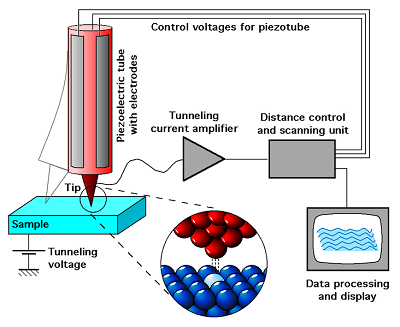The scanning tunnelling microsope (STM) is a non-optical microscope which uses the concept of quantum tunnelling by electrons to study surfaces of conductors or semi-conducors at the atomic scale of about 2 Å or 0.2 nm.
Steps:
- An atomically sharp probe (the tip) is moved over the surface of the material under study
- The electrons at the tip of the probe lack energy to overcome the electrostatic forces of attraction of the metal ions at the tip.
- The lack of energy constitutes a potential barrier for the electron.
- However, due to the effects of quantum mechanics, the electrons are able to tunnel through the barrier despite having insufficient energy.
- The amount of electron that can tunnel from the tip to the surface of the material depends on the applied potential difference and distance between the tip and the surface.
- As the tip is scanning the surface of a given material, the electronic circuit ensures that the vertical position of the tip is adjusted such that the tunnelling current is kept constant. This means that the vertical distance between the tip and surface is also a constant.
- The output display obtained is a variation of the vertical position of the tip as it is scanned across the material surface.
The STM has one serious limitation. It depends on the electrical conductivity of the sample and the tip. Unfortunately, most materials are not electrically conductive at their surfaces. Even metals, which are usually excellent electrical conductors, are covered with nonconductive oxides.
Note: Scanning tunnelling microscopy is one of the most striking techniques used to analyse surfaces since 1981. A Nobel Prize in Physics was awarded in 1986 to Gerd Binnig and Heinrich of IBM’s Zurich Laboratory in Switzerland for their invention and development of the STM.
